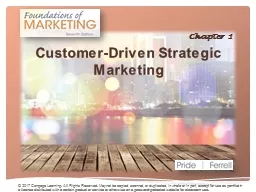

Learning Objectives 11 Define marketing 12 Explain the different variables of the marketing mix 13 Describe how marketing creates value 14 Briefly describe the marketing environment ID: 493899
Download Presentation The PPT/PDF document "Customer-Driven Strategic Marketing" is the property of its rightful owner. Permission is granted to download and print the materials on this web site for personal, non-commercial use only, and to display it on your personal computer provided you do not modify the materials and that you retain all copyright notices contained in the materials. By downloading content from our website, you accept the terms of this agreement.
Slide1
Customer-Driven Strategic MarketingSlide2
Learning Objectives
1-1
Define marketing.
1-2
Explain the different variables of the marketing mix.
1-3
Describe how marketing creates value.
1-4
Briefly describe the marketing environment.
1-5
Summarize the marketing concept.
1-6
Identify the importance of building customer relationships.
1-7
Explain why marketing is important to our global economy.Slide3
Marketing
Marketing
- creating, distributing, promoting, and pricing goods, services, and ideas to
Facilitate satisfying exchange relationships with customers
Develop and maintain favorable relationships with stakeholders in a dynamic environmentSlide4
Focus of Marketing
Customers
- purchasers of organizations’ products
Target market
- specific group of customers on whom an organization focuses its marketing effortsSlide5
Marketing Mix
Marketing mix
- decides the type and amount of elements to be used
Product
Pricing
Distribution
PromotionSlide6
Product Variable
Product
- goods, services, and ideas
Involves creating/modifying
Brand names
Packaging
Directly involved with creating products that address customers’ needs and wantsSlide7
Price Variable
Associated with establishing pricing objectives, policies, and determining product prices
Price is
A critical component of the marketing mix
Used as a competitive tool
Intense price competition leads to price warsSlide8
Distribution Variable
Ensuring availability of products in desired quantities to maximum number of target-market customers possible
Aims to keep costs low for
Inventory and transportation
Storage
Ensures availability of products
At the right time
In convenient locationsSlide9
Marketing Managers
Select/motivate intermediaries
Establish/maintain inventory control procedures
Develop/manage transportation and
storage systemsSlide10
Promotion Variable
Activities that
inform individuals or groups about the organization and its products
Increase public awareness
Educate customers about product features
Urge people to take a stance on a political or social issue
Help sustain interest in established productsSlide11
Customer Value
Customer Costs
Customer Benefits
Marketing Creates ValueSlide12
Value
Value
- customer’s subjective assessment of benefits relative to costs in determining the worth of a product
Customer benefits - anything a buyer receives in an exchange
Customer costs - anything a buyer must give up to obtain the benefits of the product
Marketing mix enhances perceptions of valueSlide13
Exchange
Exchanges
- provision or transfer of goods, services, or ideas in return for something of value
Two or more parties possessing something of value that the other party desires must participate
Should provide a benefit
Each party must have confidence in the promise held by the other
Parties must meet expectations to build trustSlide14
Stakeholders
Stakeholders
- constituents who have a stake in some aspect of a company’s products, operations, markets, industry, and outcomes
Customers
Employees
Investors
Shareholders
Suppliers
Governments
CommunitiesSlide15
Marketing Environment
Marketing environment
- constitutes the following forces
Competitive
Economic
Political
Legal and regulatory
Technological
Socio-cultural
Surrounds the customer and affects the marketing mixSlide16
Affects of Marketing Environment
Affects a marketer’s ability to facilitate value-driven marketing exchanges
Influences customers by affecting their
Lifestyle
Standards of living
Preferences and needs for products
Affects a marketing manager’s decisions and actionsSlide17
Marketing Concept
Marketing concept
- adopting a coordinated set of activities that
Satisfy customers’ needs
Aid the organization in achieving its goals
Guides an organization’s overall activities
Customers are the main focusSlide18
Market orientation
Sales orientation
Production orientation
Evolution of the Marketing ConceptSlide19
Market Orientation
Market orientation
- requires an organization-wide generation of market intelligence pertaining to
Current and future customer needs
Dissemination of the intelligence across departments
Organization wide responsiveness
Linked to new-product innovation
Developing a strategic focus to explore
Developing new products to serve target markets
Being responsive to ever-changing customer needs and wantsSlide20
Company must coordinate all its activities to satisfy objectives
Listen and respond to consumers frustrations and appreciation
Use the information to create satisfying products
Establish an information system to discover customers’ real needs
Implementing the Marketing ConceptSlide21
Customer Relationship Management
Customer relationship management (CRM)
- using information about customers to create marketing strategies that develop and sustain desirable customer relationships
Acquiring new customers
Enhancing profitability of existing customers
Extending the duration of customer relationshipsSlide22
Relationship Marketing
Relationship marketing
- long-term and mutually beneficial arrangement
Deepens the buyers trust
Building satisfying exchange relationships between buyers and sellers requires
Gathering useful data at all customer contact points
Analyzing that data to better understand customers’ needs, desires, and habitsSlide23
The Importance of Marketing
in a Global Economy
Marketing costs consume a sizable portion of buyers’ dollars
Used in nonprofit organizations
Important to businesses and the economy
Fuels global economy
Marketing knowledge enhances consumer awareness
Connects people through technologySlide24
The Importance of Marketing
in a Global Economy
(continued)
Socially responsible marketing - promoting the welfare of customers and stakeholders
Green marketing
- strategic process involving stakeholder assessment to
Create meaningful, long-term relationships with customers
Maintain, support, and enhance the natural environment
Market orientation combined with social responsibility improves business performance